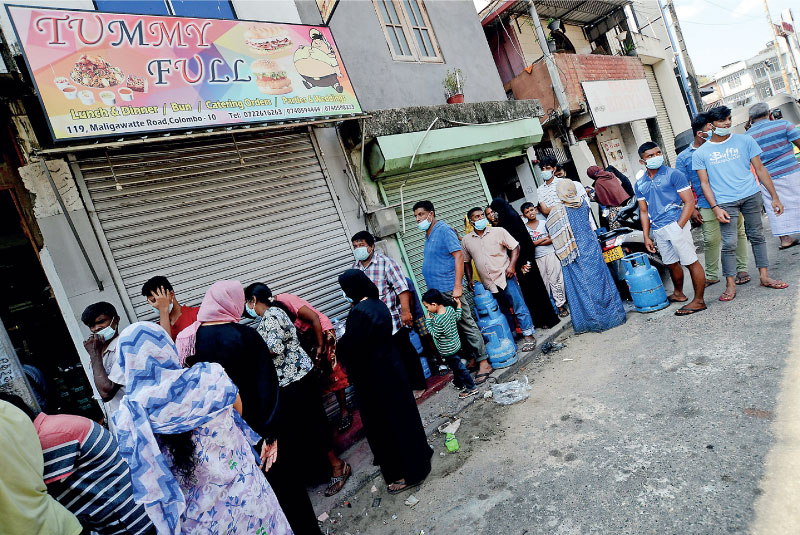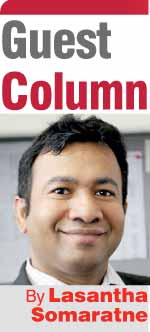Monday Apr 07, 2025
Monday Apr 07, 2025
Wednesday, 30 March 2022 02:05 - - {{hitsCtrl.values.hits}}

People have to wait in long queues for daily essentials like LP Gas, fuel, milk foods, etc… a completely unfamiliar situation in the modern era – Pic by Shehan Gunasekara
|
 Sri Lanka is going through an unprecedented economic crisis. It is believed to be the worst economic crisis since the country’s independence in 1948. People have to wait in long queues for daily essentials like LP Gas, fuel, milk foods, etc… a completely unfamiliar situation in the modern era. The last time Sri Lanka has seen similar queues was under the closed economic policy, adopted by SLFP-led Government back in the 1970s. While many have expressed their views about the economic crisis and solutions, it is also important to understand the trajectory that the country took to reach this status.In the 1970s, Sri Lanka followed a closed economic policy. The Government in 1978 decided to adopt an open economic policy. The open economic policy encourages wide private sector participation and integrates Sri Lanka with the global economy. Soon after the introduction of the open economy, Sri Lanka went through an insurgency and then followed by a 30-year civil conflict which kept most productive assets away from economic activity. Since 2000, the policies adopted by the governments led by SLFP/SLPP were mostly inward-looking and relied on heavy State spending in many areas. As a result of left centric economic policies, the State sector expanded disproportionately large compared to the rest of the economy. Productive industrial and export sectors with a good start in the early 1980s didn’t receive the same attention from the Government. The expanding Government sector failed to generate sufficient productive capacity while growing red tapes and bureaucracy diminished Sri Lanka’s competitiveness.
Sri Lanka is going through an unprecedented economic crisis. It is believed to be the worst economic crisis since the country’s independence in 1948. People have to wait in long queues for daily essentials like LP Gas, fuel, milk foods, etc… a completely unfamiliar situation in the modern era. The last time Sri Lanka has seen similar queues was under the closed economic policy, adopted by SLFP-led Government back in the 1970s. While many have expressed their views about the economic crisis and solutions, it is also important to understand the trajectory that the country took to reach this status.In the 1970s, Sri Lanka followed a closed economic policy. The Government in 1978 decided to adopt an open economic policy. The open economic policy encourages wide private sector participation and integrates Sri Lanka with the global economy. Soon after the introduction of the open economy, Sri Lanka went through an insurgency and then followed by a 30-year civil conflict which kept most productive assets away from economic activity. Since 2000, the policies adopted by the governments led by SLFP/SLPP were mostly inward-looking and relied on heavy State spending in many areas. As a result of left centric economic policies, the State sector expanded disproportionately large compared to the rest of the economy. Productive industrial and export sectors with a good start in the early 1980s didn’t receive the same attention from the Government. The expanding Government sector failed to generate sufficient productive capacity while growing red tapes and bureaucracy diminished Sri Lanka’s competitiveness.
To add more to this degenerative condition, Sri Lanka’s monetary and fiscal policy throughout this period was counterproductive. It was clearly evident that the Central Bank deviated from the stated flexible exchange rate policy, maintaining a soft peg to the US dollar while the country was experiencing a high domestic inflation.
Sri Lanka achieved around 5% GDP growth rate during the 2000-2015 period, while post-war economic boom led by disproportionate deficit funded public spending claimed a higher GDP growth around 7-8% during three years from 2010. Economists argue that the GDP growth since 2000 had largely derived from the non-tradable sectors while the tradable sector contribution to the GDP has gradually diminished.
It is important to understand the difference between tradable goods and non-tradable goods and the implication of a growth model driven by the non-tradable goods. Non-tradable goods can only be consumed within the economy in which they are produced; they cannot be exported or imported. Tradable goods are exported and imported across the borders. Countries could export tradable goods and earn foreign exchange. In contrast, non-tradable goods won’t generate export income; hence the country cannot earn foreign exchange.
The long-term growth derived from non-tradable goods will generate economic growth, nevertheless no corresponding export income. The economic growth or growth of affluent within the economy though it is derived from non-tradable goods, will demand imported goods. Sri Lanka’s economic growth increased the demand for consumer goods such as motor cars, fuel, electronics which are not produced in the country. Low exports or low foreign exchange inflows and more demand for imported goods created sustained gap between merchandise imports and exports.
While successive governments since 2000 have failed to create a conducive environment for exports, the growth of import demand emanated from non-tradable sector driven economic growth created a sustained large gap in the trade account.
The monetary and economic policies adopted during the decade from 2000-2010, resulted in higher sustained inflation while the exchange rate was artificially held. This was once termed as “double jeopardy”. Higher domestic inflation results in higher input cost for the exporters depending on their level of value addition. If local value addition is higher, then cost escalation of the exporter is also higher. As a result, high value-added exports were largely penalised. Contrastingly, artificially held exchange rate resulted in no corresponding gains in the export values. If the exchange rate is not depreciated to compensate for the high input costs (higher domestic inflation), the profit margins of exporters are persistently deteriorated. Some exporters find it difficult to continue while foreign buyers divert to cost-effective alternative destinations. Combined effect of such policies on the country’s export sector was highly unfavourable.
When a country adopts such an imprudent policy in the long run, entrepreneurs gradually leave export industries and switch to local industries serving the domestic market. Prevailing high inflation allows domestic enterprises to maintain profit margins through continuous price adjustments in the domestic market. Under such an environment, industrialists lobby for protectionism and focus on profiting from import substitution industries.
Even though the Government adopts pro-industrial policies, the country won’t be able to sustain growth in exports under uncompetitive monetary and exchange rate policies. Sri Lanka experienced this phenomenon since 2000; the country experienced a continuous decline in investments into export industries.
Sri Lanka failed to develop any industry with world recognition, except apparel manufacturing which has carved a niche in the world apparel industry. The size of the apparel industry with export value of $ 5 billion is too small for $ 80/90 billion economy. Local value addition in the apparel industry is even low with 50-60% imported raw materials. Sri Lanka needs serious effort to modernise and diversify its export base.
|
During the past two decades, Sri Lanka didn’t enter into any meaningful trade negotiation with its trading partners. At this moment, the country is struggling to maintain concessionary trade access to the European Union. Sri Lanka lost GSP plus concessionary trade access to the EU and regained the access in 2016. Loss of GSP plus resulted in a major blow to a wide range of our industries involved in manufacturing goods for European market. Exporters in other countries to Europe grabbed market share from our exporters as they could produce and export at more competitive prices than us while enjoying benefits of competitive currencies.
High domestic inflation, artificially held exchange rate and losing concessionary trade access to the major market were a fatal combination. Sri Lanka has not been able to create a conducive environment to foster export-oriented industries. As a result, the country experienced a continuous stagnation and in certain cases, a decline in exports. This continuous downfall of the export is attributed to persistent unfavourable policies.
Sri Lanka is officially adopting a free floating exchange rate; this means the demand and supply will decide the equilibrium price; the exchange rate. In contrast to the stated policy, the Central Bank has been maintaining sift peg exchange rate since August 2021. Though it was not the first time, artificial exchange rate this time created another unprecedented crisis. Sri Lanka receives $ 6-7 billion annual inflow of foreign currency from Sri Lankan migrant workers. Workers’ remittances declined drastically as a result of the fixed exchange rate. Parallel informal market offered relatively higher rate with expectation of sharp devaluation in the exchange rate. The decision to allow the exchange rate to be decided by the market forces will attract high workers’ remittances; however, Sri Lanka had already lost nearly $ 3 billion as a result of above decision to maintain a fixed exchange rate since August 2021.
The root cause of the current exchange rate crisis is the structural deficiencies created by long-term imprudent policies. Economic development of a country goes through a natural transformation process, moving initially from the agriculture sector to industrial sector and then to service sector. Sri Lanka had never achieved an industrial sector dominance in the GDP. Owing to inward-looking economic policy combined with unfavourable monetary and exchange rate policies, the country failed to develop a sufficiently large export-oriented industrial sector.
Learning from the past mistakes, it is necessary that the country should adhere to monetary and exchange rate policies which should foster exports growth, discourage unnecessary imports and maintain long-term structural sustainability of the economy. The exchange rate decides the competitiveness of a country’s exports vis-à-vis its trading partners. Domestic price stability and competitive exchange rate in the long run create an environment for a sustainable export sector. The country should commit to a consistent long-run policy framework to create a conducive environment for generating more exports business opportunities.
|


(The writer is a CFA charterholder and Certified FRM with 20 years’ local and international capital market experience. The views and opinions expressed in this article are those of the writer and do not necessarily reflect the official policy or position of any institution.)
Discover Kapruka, the leading online shopping platform in Sri Lanka, where you can conveniently send Gifts and Flowers to your loved ones for any event including Valentine ’s Day. Explore a wide range of popular Shopping Categories on Kapruka, including Toys, Groceries, Electronics, Birthday Cakes, Fruits, Chocolates, Flower Bouquets, Clothing, Watches, Lingerie, Gift Sets and Jewellery. Also if you’re interested in selling with Kapruka, Partner Central by Kapruka is the best solution to start with. Moreover, through Kapruka Global Shop, you can also enjoy the convenience of purchasing products from renowned platforms like Amazon and eBay and have them delivered to Sri Lanka.
Discover Kapruka, the leading online shopping platform in Sri Lanka, where you can conveniently send Gifts and Flowers to your loved ones for any event including Valentine ’s Day. Explore a wide range of popular Shopping Categories on Kapruka, including Toys, Groceries, Electronics, Birthday Cakes, Fruits, Chocolates, Flower Bouquets, Clothing, Watches, Lingerie, Gift Sets and Jewellery. Also if you’re interested in selling with Kapruka, Partner Central by Kapruka is the best solution to start with. Moreover, through Kapruka Global Shop, you can also enjoy the convenience of purchasing products from renowned platforms like Amazon and eBay and have them delivered to Sri Lanka.